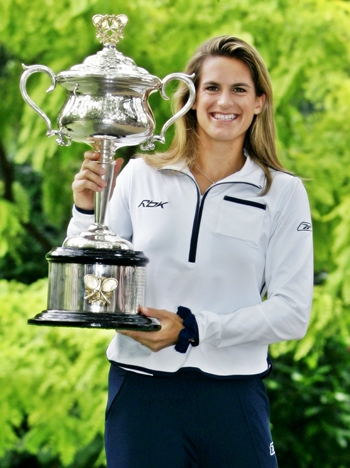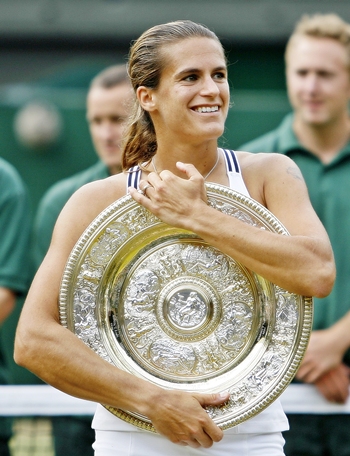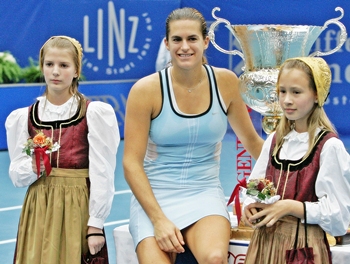
In an era where women's tennis, with a few notable exceptions, has churned out robotic, baseline sluggers, Amelie Mauresmo always stood out from the crowd, even if her results did not always match her flair.
Like one of the fine vintage wines she avidly collects, Mauresmo's game was full of flavour and Gallic charm and made for an enjoyable distraction from the one-dimensional fizzy pop tennis that now dominates the Tour.
The 30-year-old's decision on Thursday to hang up her racket was hardly a surprising one, injuries and age have made it increasingly hard for her to compete at the top, but the former world number one and twice grand slam champion will be missed.

When Mauresmo burst on to the scene by reaching the Australian Open final unseeded in 1999 it appeared the Frenchwoman had all the assets to scale the heights achieved by compatriot Suzanne Lenglen in the 1920s.
Blessed with superb athleticism and power, she also possessed a wonderful touch, a backhand that was poetry in motion and a range of spins and angles that are beyond the imagination of many of today's top woman players.
Mauresmo was also happy to leave comfort of the baseline and attack the net off a slice backhand reminiscent of the great Martina Navratilova.
It was no surprise that the music-loving Mauresmo idolised Yannick Noah as a child.
Like the 1983 French Open champion she moved with almost balletic grace and played the game with panache and a dash of flamboyance.

However, Mauresmo's ability to conjure shots was at odds with her self belief.
She struggled to live up to the expectations placed on her shoulders, particularly at the French Open where she often wilted under the pressure of home hopes and never went past the quarter-finals on the Roland Garros clay.
But the same fragility that made her so infuriating to French fans, also made her endearing.
There was a sense that her game could go wrong at any moment but when everything came together, there were few better sights in tennis.

Off-court too, Mauresmo was different.
When in 1999 she came out as a lesbian, her refreshing openness about her sexuality became the subject of scorn amongst some of her fellow players.
With admirable dignity, Mauresmo let her tennis do the talking and she became established as one of the biggest draws in the sport, ending the year in the top 10 from 2001 to 2006 and reaching the number one spot for the first time in 2004.
Her lack of grand slam success overshadowed her consistency on the Tour, however, and the question of whether she really had the mental toughness to land a major was one of the most frequently asked in tennis.

In 2006, seven years after her maiden grand slam final, she was finally able to fill in the blank on her CV by winning the Australian Open, although the questions marks refused to go away as Justin Henin retired ill during the final.
Whatever the merits of that title, it did lift the monkey off Mauresmo's back and she went on to enjoy the best year of her career, spending much of it as world number one.
Her crowning moment arrived in July when she became the first Frenchwoman in the professional era to win Wimbledon, coming back from a set down to beat Henin on Centre Court.
It was a final that summed up Mauresmo's appeal.
Sublime tennis mixed with moments of self-doubt, but she held herself together to become one of the most popular winners of the grasscourt grand slam in recent years.

A semi-final appearance at the US Open later in 2006 marked the last time that Mauresmo would challenge for a grand slam title as her career began to wane.
Factbox on twice grand slam winner and former world number one Amelie Mauresmo who announced her retirement on Thursday:
* Born on July 5, 1979 in St Germain en Laye, France.
* Started playing tennis at the age of four after being inspired by compatriot Yannick Noah winning the 1983 French Open.
* Turned professional in 1997.
* Breakthrough year came in 1999 when she reached the final of the Australian Open as an unseeded player, beating top seed Lindsay Davenport before losing to Martina Hingis. Won her first title in Bratislava.
* Won the 2000 Sydney International, beating world number one Hingis in the semi-finals and number two Davenport in the final.
* Surpassed Mary Pierce as top-ranked Frenchwoman in 2001 after a 16-match winning streak earned three successive titles in Paris, Nice and Amelia Island.
* Helped France to second Fed Cup title in 2003.
* Suffered an injury-plagued 2004 but still won a silver medal at Athens Olympics and became the first Frenchwoman to take world number one ranking in September of same year.
* Mauresmo, showing one of the best backhands on tour, won her first grand slam title at the 2006 Australian Open after Belgian Justine Henin-Hardenne retired in the final through illness.
* Became the first Frenchwoman since Suzanne Lenglen in 1925 to win the Wimbledon singles, again defeating Henin-Hardenne in the final.
* Following her Antwerp Diamond Games victory in 2007 she took longer than expected to recover from an appendectomy and suffered a series of injuries.
* Mauresmo spent a long time in the wilderness and thought about quitting before storming back to claim the Paris Open title in February 2009.
* Lost in the fourth round at Wimbledon and did not play again after losing to Canada's Aleksandra Wozniak in the second round of the US Open in September.
* Ends career with 25 WTA Tour singles crowns.